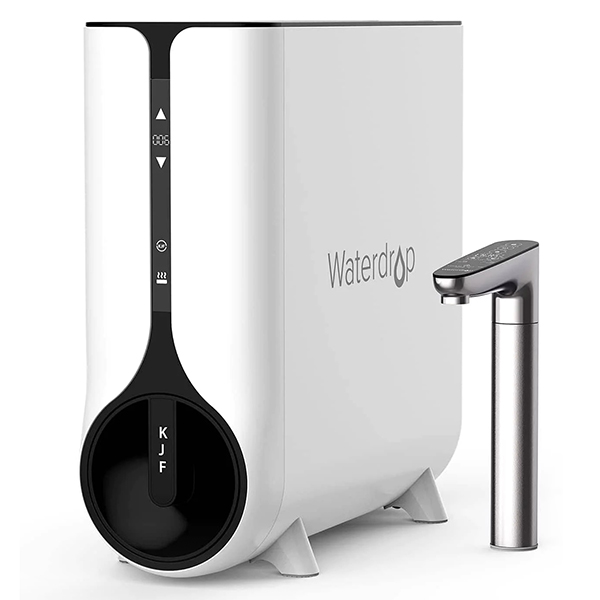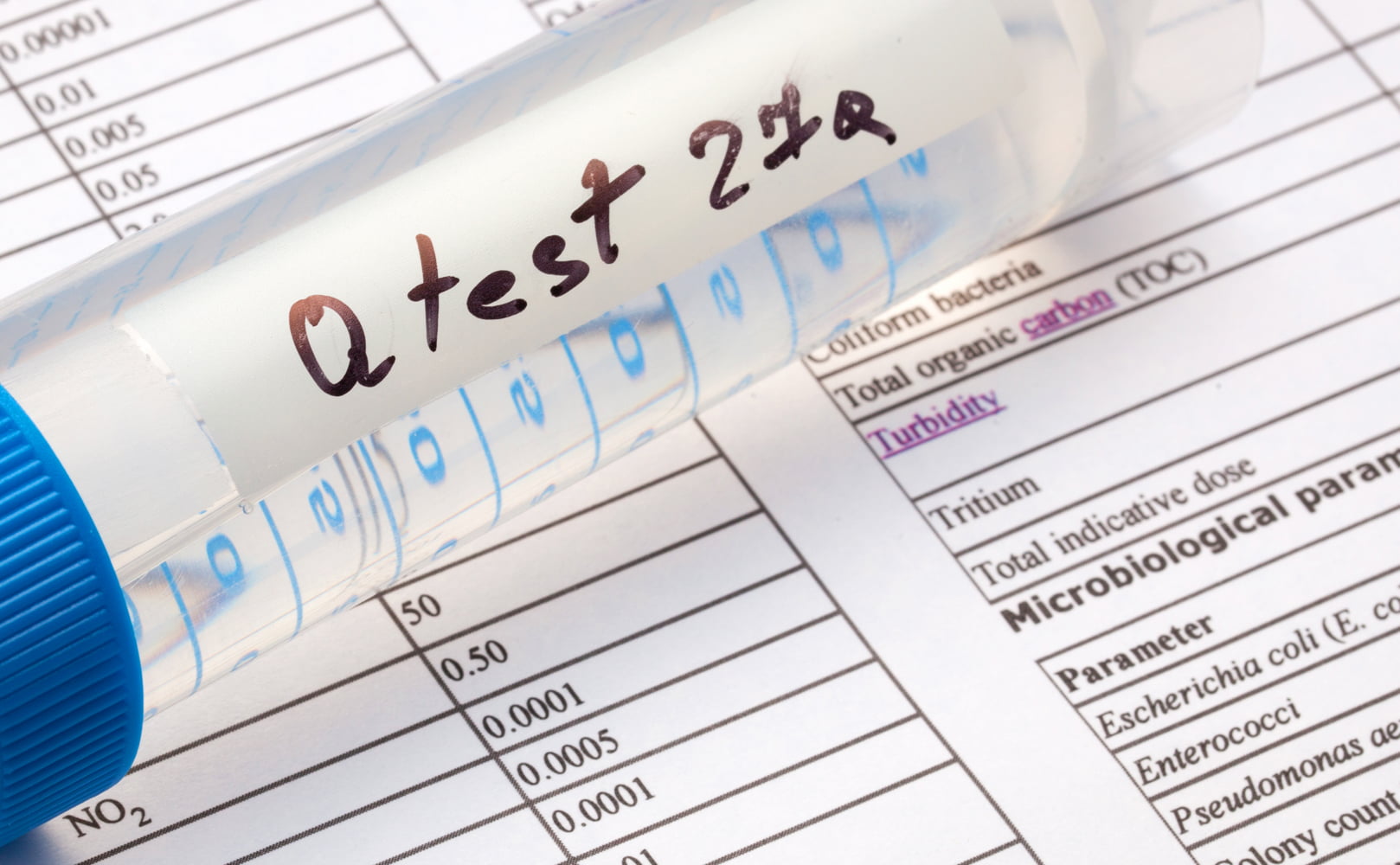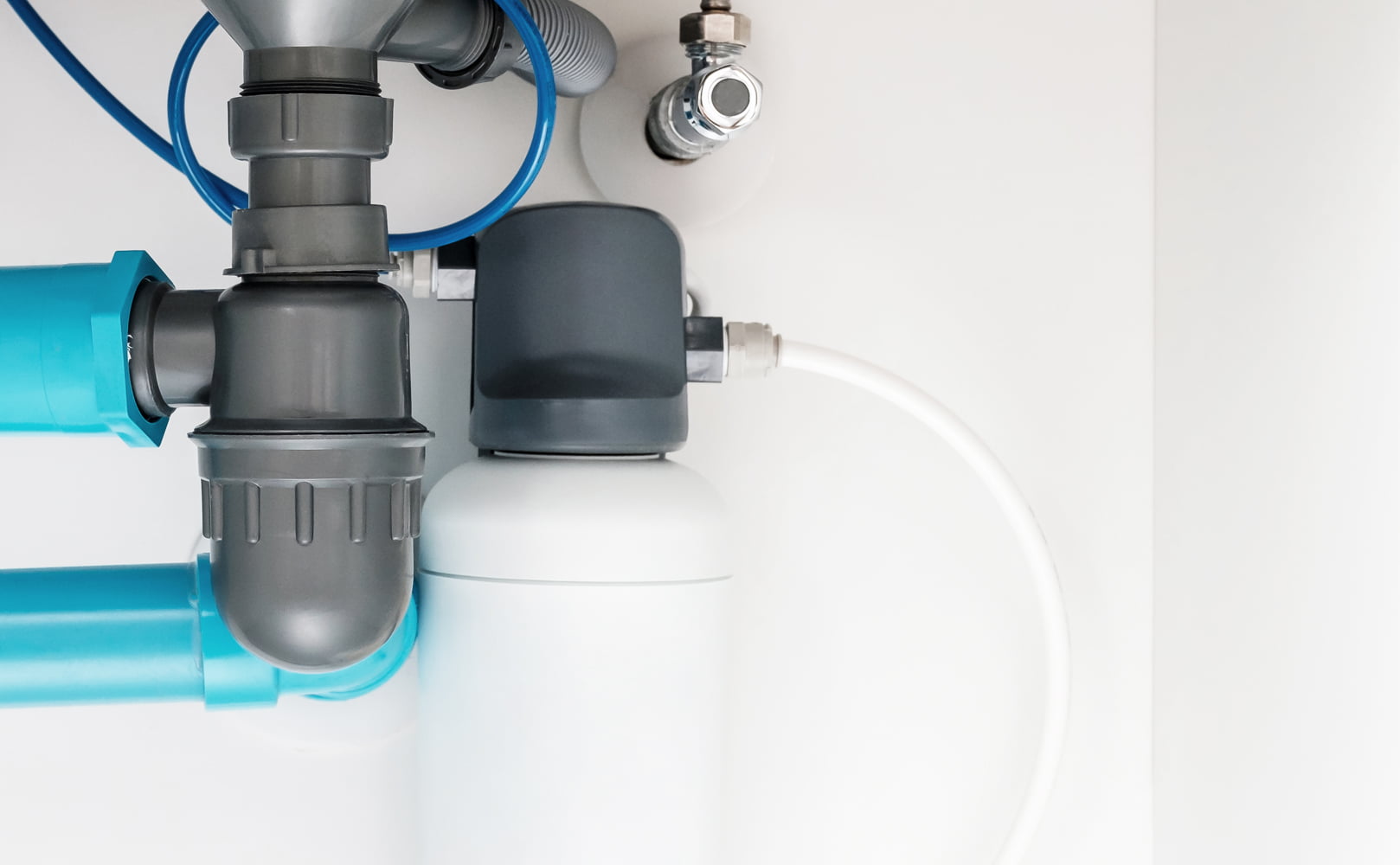Best Under Sink Hot and Cold Water Filter Systems (*Update 2024)
Written by: Gene Fitzgerald // Expert Fact-Checking: Buddhini Dolapihilla, MBSS // Last Updated: Jan 31, 2024
This page may contain affiliate links. If you buy a product or service through such a link we earn a commission at no extra cost to you. Learn more.
Top Pick: What’s the Best Under Sink Hot and Cold Water Filter?
The best under sink hot and cold water filter in 2024 is the Waterdrop K6, because it is NSF-tested to remove most harmful water contaminants, it provides steaming hot water, and it is fast, quite easy to install, even easier and affordable to maintain, and it has a long filter life of up to 1,600 gallons.
Usually, there are several if not dozens of different products to choose from in any given category. With under sink hot and cold water filters it’s different. At the time of writing this guide, there’s only a single model on the market: The Waterdrop K6.
Let’s find out if it’s good. We’ll also be talking about what to consider when shopping for an under sink hot and cold water filter among other useful information. Simply put, we want to enable you to make the best buying decision for when there are more systems available.
No Time to Read? Check Our List of the Best Under Sink Hot and Cold Water Filters!
| Product | Details | |
|---|---|---|
 Best Overall: Waterdrop K6 |
Overall Rating: 4.5/5.0 ⓘRatings based on filter process, NSF standards, life of filter elements, water temperature settings, cost, our testing, user feedback, product warranty and support, and other factors.
Get 10% Off! Use Code: |
Price: $$$ Type: Reverse Osmosis System Filter Life: 1,600 Gallons NSF: 42, 53, 58 Hot/Cold Water Temp: Up to 203 °F Read Review: Click |
Under Sink Hot and Cold Water Filter Reviews
Our Top Picks
- Waterdrop K6 – Best Overall
1. Best Overall: Waterdrop K6 Instant Hot & Cold Water Dispenser and Reverse Osmosis System
In our opinion, the best under sink hot and cold water filter in 2024 is the Waterdrop K6. But it’s not only the best, it’s also the only under sink water filter system that can provide both hot and cold water currently on the market.
That does not make it bad, though – far from it! The K6 looks very, very promising. More details below.
Other Specs
- Model: K6
- Last Price: $799.99
- Annual Maintenance Cost: ~$140
- Filter Media/Process: Sediment Filtration, Activated Carbon, RO
- Filter Stages: 5
- Flow Rate: 0.4 gpm
- WxHxD: 17.5″x16.6″x6.7″
- Input Water Temperature: 5-38 °F
- Water Pressure: 14.5-87 psi
- Fitting: 3/8″ or 1/2″
- Warranty: 1 Year (Limited)
Key Features & Pros
- The K6 system combines reverse osmosis filtration with a hot water heater to dispense both hot and cold RO-filtered water.
- Water temperature options range from room temperature up to 203°F (steaming hot water).
- 5 filter stages remove a wide variety of contaminants.
- Stage 1: PP (polypropylene) cotton pre-filter traps and removes sand, silt, and sediment.
- Stage 2: Carbon fiber pre-filter separates and removes chlorine (which must be removed to avoid damage to the membrane), organic contaminants, as well as foul tastes and odors.
- Stage 3: This is the primary filter stage, the reverse osmosis membrane. This stage removes an incredible array of contaminants including TDS (total dissolved solids), microbes, asbestos, heavy metals, salts, pesticides/herbicides, and much more.
- Stage 4: Carbon block post-filter eliminates any remaining contaminants and helps to ‘polish’ the taste and odor of the water.
- Stage 5: A final polypropylene cotton layer removes any remaining sediment or particulates from your drinking water.
- The system is tested to NSF standards 42, 58, and 53. Altogether, the system will remove over 99% of chlorine, 99% of fluoride, 99% of arsenic, 99% of chromium 6, 99% of lead, 99% of PFOS/PFOA, 99% of chlorate, 93% of nitrate, 98% of TDS, 99.999% of total coliforms, and more.
- The RO membrane removes limescale from the water so that the heating element won’t get clogged with scale over time.
- Due to the 600 gpd (gallons per day) RO membrane rating and an internal pump, the water flow is fast, so you won’t need to wait more than a few seconds to fill a glass of water.
- 4 gpm flow is exceptionally fast for an RO filter system.
- The pressure pump also helps to reduce wastewater production to a minimum. The 2 to 1 filtered water to wastewater ratio is significantly lower than the 4:1 ratio typical to most RO systems.
- The included smart faucet looks sleek and modern and adds extra functionality with its touch display.
- The digital control panel allows you to set the water temperature, dispense water, engage and disengage the child lock, as well as display the remaining filter lifespan, and show the level of TDS in your filtered water.
- System front panel also shows output water TDS, a filter reset indicator, and you can also control temperature here.
- Safety measures in place to prevent dry burning of water.
- Made only with BPA-free materials.
- Filter lasts for approximately 12 months or 1,600 gallons.
- Filter replacements are quick and easy.
- The annual cost comes to just $140 – making it highly affordable for this type of system.
- 30-day worry-free money-back guarantee.
- 1-year limited manufacturer warranty plus lifetime technical support.
Cons
- The system is called an “instant hot water system”, but this is a bit of a misnomer. The heating temperature must be set in advance, and only when the hot water has reached the desired temperature can you dispense it. Once the internal 70-ounce tank is emptied, you’ll need to wait for the tank to refill before you dispense water.
- Does not really dispense cold water, but temperature of feed water.
- We have no actual NSF certifications, only NSF testing.
Our Rating
- Filter Performance: 5.0/5.0
- Filter Capacity: 5.0/5.0
- Price: 4.0/5.0
- Annual Cost: 5.0/5.0
- Overall: 4.5/5.0
Best for
At this point, the Waterdrop K6 is your best option if you’re looking for an under sink system that can dispense both hot and cold water. It’s also the only system offering this at the moment, nonetheless, it seems like a promising, feature-rich unit.
→ Full Waterdrop K6 System Review
- We Love These Under Sink Water Filters!
- Best Tankless Under Sink Water Filter? Right Here!
- Best Under Sink Water Filters Using Carbon
- Explore the Best Single-Stage Under-the-Sink Water Filters!
- Apartment Under Sink Water Filter Reviews
- Best Under Sink Hard Water Filter Systems
- List with All Under Sink Water Filters Featured on BOS
Comparison List
(Mobile Hint: Swipe to Scroll)
| Model | Price | Filter Type | Filter Capacity | NSF Standards | Water Temperature | Annual Cost | Warranty | Additional Info |
|---|---|---|---|---|---|---|---|---|
| Waterdrop K6 Instant Hot & Cold Water Dispenser and Reverse Osmosis System | $$$ | RO System | 1,600 gal | 42, 53, 58 | Up to 203 °F | ~$140 | 1 Year (Limited) |
Buying Guide: How to Choose the Under-the-Sink Hot & Cold Water Filter That’s Best for You
The following are key features worth considering when shopping for an under sink hot and cold water filter. They will help you choose the right one for your needs and budget.
Matching Your Water Conditions with the Right Filtration Technology
Whenever you’re picking out a water filter for your home, the first step is generally to determine the type and quantity of contaminants you’re dealing with. This will either involve testing your water by hand or in a lab or using publicly available resources to check contaminant quantities.
If your water is supplied by a well, then the only surefire method to check your contaminant levels is through your own testing. This can either be done with a home test kit (which is fast and cheap but less accurate) or through professional testing (which is costlier and slower but more precise).
If your water is municipally supplied, then the easiest option is to consult publicly available resources like the EPA’s Safewater or EWG’s Tap Water Database, which provide recent data on the contaminant levels in your local water supply.
NSF Testing/Certifications
NSF testing and certifications are the number one way you as a consumer can be sure that the claims made by the filter manufacturer are accurate. The NSF is an independent organization that conducts third-party testing and issues standards about the accuracy of water filters and other appliance manufacturers.
When it comes to under-sink hot and cold water filter systems, the standards to be aware of are the following:
- NSF Standard 42: This standard refers to the removal of ‘aesthetic effects’ from your water. This refers to chlorine/chloramine, particulates, and foul taste and odor.
- NSF Standard 53: This standard refers to the removal of contaminants with ‘health effects’ from water. This includes pollutants like lead, radon, mercury, asbestos bacteria, cysts, and VOCs.
- NSF Standard 58: This standard is specific to point-of-use reverse osmosis systems, and refers to the removal of nitrates/nitrites, arsenic, cysts, lead, copper, mercury, fluoride, and more.
- NSF Standard 401: NSF 401 is for emerging chemicals like trace pharmaceuticals.
Output Water Flow
A system’s output water flow refers to the speed at which water is dispensed when the faucet is opened. Flow rates are typically measured in gallons per minute (gpm).
Flow rates are of particular importance for an under sink filter system without a dedicated faucet. As these systems filter all of the water dispensed by your kitchen faucet, a low flow rate will have a major impact on your day-to-day usage.
Generally speaking, a typical kitchen sink dispenses water at about 2 gpm. Between 1 and 2 gpm you’re unlikely to notice much reduction in your flow rate, whereas under 1 gpm you’ll start to notice a distinctive slowdown. That said, for reverse osmosis systems like the Waterdrop K6 above, lower flow rates are normal, and essentially unavoidable due to the design of RO membranes. That said, the K6 comes with its own dedicated faucet, so there is nothing to worry about.
Water Heating Process
If you require the convenience of instant hot water on demand, this requires an under sink water filter to continuously heat water on an ongoing basis to keep the water hot. This is significantly more energy-intensive than systems that heat water on demand, so you’ll want to weigh the pros and cons as well as consider your usage requirements.
If you are interested in a system with continuous hot water, then you’ll also want to consider the level of heat loss and the system’s efficiency at keeping water hot as these will have major impacts on your energy usage.
Heating Efficiency
The importance of heating efficiency will depend on the design of the system in question. For tankless systems, heating efficiency plays a fairly minor role, as nearly all of these types (over 95%) are highly energy efficient.
Cold and Hot Water Temperature
Another important consideration is the range of available temperatures offered by the system. As far as cold water is concerned this can simply mean room temperature, whereas hot water typically will have a maximum temperature measured in degrees.
Temperature Control
A system with good temperature control should be easy to use and allow you to adjust your output water temperature simply by turning a knob or pressing a button.
System Installation and Maintenance
An under sink hot and cold water filter should typically be no more difficult to install than regular under sink systems. The entire process can often be completed in less than an hour, and specialized plumbing or DIY skills aren’t required.
Systems with reverse osmosis will require a drain hookup and drain saddle as well – which makes installation slightly more complex.
Space
The addition of a hot water heater to any system will inevitably increase the space requirements. This is essentially unavoidable, as the heating element and tank (if present) take up a significant amount of real estate.
One thing to consider is that adding a separate hot water heater to your under sink system would likely take up even more space than having them combined in a single unit, so space could be a limited factor in either situation.
Price Points
When considering the cost of an under sink hot and cold water filter, there is more to consider than the retail price alone. A system’s annual maintenance cost (the cost of replacing the filter elements and/or membrane) must be considered, as well as the energy demand of the heating element.
As heating hot water constantly is a fairly energy-intensive task, an inefficient system can potentially cost you a significant amount in increased energy bills.
More on Under Sink Hot and Cold Water Filters
What Is an Under Sink Hot and Cold Water Filter System?
An under sink hot and cold water filter is any system installed in an under sink cabinet capable of dispensing both hot and cold filtered water. As these systems feature more complex designs and possess higher energy requirements, they are very rare.
How It Works
An under sink water filter with both hot and cold filtration will necessarily filter the water before heating it. The reasons for this are twofold: first, sending hot water through any filter system will quickly damage it, and second, not all of the water dispensed from the faucet will be hot, so heating it before filtration would waste unnecessary energy.
Depending on the system in question, the initial filtration process will differ. It can involve reverse osmosis filtration like the K6 system above, or it can use another filter type like carbon or KDF filter media.
Following the filtration process, the filtered water flows either directly to the faucet (for cold water) or to the water heating element (for hot water).
While there aren’t many of these systems on the market currently, under sink hot and cold water filters will likely use dedicated faucets for better control over water temperature in the future.
Side note: Of course, you could always use any under sink water filter and then a separate under sink water heater, but the Waterdrop K6 is the only system that combines all in one.
Who Should Buy a Hot & Cold Water Filter for Under the Sink?
Under sink hot and cold water systems are nothing new, but the combination with a filter stage is a newer innovation. These systems are ideal options for anyone with serious contamination in their water supply or anyone with a high demand for filtered hot water.
Installation and Maintenance
Generally speaking, under sink hot and cold water filters are no more difficult to install and maintain than regular under sink systems, but this will differ somewhat depending on the specifics.
Taking the K6 above as an example, the installation process will look something like this:
- Shut off the feed water supply under your kitchen sink and open the faucet to relieve any pressure.
- Disconnect the cold water line from the valve. Then, attach the feed water adapter to the cold water supply valve and tighten it with a wrench or pliers.
- Now, install the smart faucet to your kitchen sink. This can be done via an existing hole, if not you’ll need to drill a new one through the countertop or sink.
- Now, the drain saddle will need to be installed. This involves drilling a small hole into the drain pipe and running the drain line from the system to the saddle.
- At this point, install the system housing in the under sink cabinet. You’ll need to ensure you have sufficient clearance for the system and the tubing attachments.
- Once the system is positioned in its installation location, connect the various tubing connections for the ‘inlet’, ‘pure’, ‘hot’, and ‘drain’ lines.
- Now, run the power cord from the electrical outlet to the system.
- At this point, the system is ready to start up. First, turn on the cold water supply, insert the power plug, then allow the system to automatically flush for 1 minute followed by opening the faucet and flushing for 10 minutes.
- Finally, check all of the tubing connections during the flushing process for any leaks.
The one major maintenance task is replacing the filter elements. With the Waterdrop K6, this takes no more than a few minutes.
Frequently Asked Questions (FAQ)
- Does hot water filter better than cold water?
No, hot water will pass through the filter element easier, which means the filtration process will be less effective. That’s why it’s important to have the filtration step before the heating. - Is hot water from a water filter good?
It is as good as cold water from a water filter. There is no difference between hot and cold filtered water, as long as the filtration step came before the heating. - How much does an under sink hot and cold water filter cost?
The only model currently available is the Waterdrop K6 which costs .99.
How We Chose and Tested the Best Under Sink Hot and Cold Water Filters (Why Trust Us)
Want a glance at our methodology reviewing under sink hot & cold water filters?
- Thoughtful Criteria: We began by establishing a comprehensive set of 21 attributes to evaluate all products against, drawing on our extensive experience and research.
- Gathering Products: We soon found that there was only a single hot/cold under sink water filter available. Well, we added it to our list.
- Rigorous Evaluation: We meticulously examined the product’s manual, description, third-party certifications/test data, and warranty. Moreover, we reached out to Waterdrop to gauge their level of support and address potential customer inquiries.
- User Feedback: We checked for positive and negative customer reviews on waterdropfilter.com.
- Hands-on Testing: At this stage, we procured and installed the Waterdrop K6. Following provided instructions, it was carefully set up and left to operate for a minimum of three weeks. Our evaluation encompassed multiple aspects, such as ease of installation and filter priming, space and maintenance requirements, usability, and the taste and odor of filtered water, ensuring a comprehensive assessment.
- Lab Testing: To evaluate contaminant reduction rates (including THMs, lead, fluoride, and more), we conducted our own laboratory testing using ETR Laboratories.
- Insightful Analysis: Once we gathered all the data, we transformed technical specifications into easily comprehensible insights. All our reviews are presented in a balanced pros vs cons format, offering a well-rounded perspective on each product.
- Independence and Accuracy: We take great pride in our unbiased approach. All of our reviews and ratings are independent, and our content is thoroughly fact-checked by professionals to ensure accuracy. In assessing claims related to contamination reduction, we entrusted Buddhini Dolapihilla, MBSS, with the critical task of verifying NSF certifications and test data.
About Our Ratings
Our evaluation process for under-the-sink hot and cold water filter systems is mostly based on these factors: NSF-based contaminant reduction rates (25%), price and yearly cost (20%), water temperatures (15%), our testing and third-party user opinions (15%), filter life (15%), customer service and product warranty (10%).
We’ve rated each system on a score of 1 to 5, with 5 being the highest rating.
Questions? Ask away!
Information provided on BOS is for educational purposes only. The products and services we review may not be right for your individual circumstances.
We adhere to strict editorial guidelines. Rest assured, the opinions expressed have not been provided, reviewed, or otherwise endorsed by our partners – they are unbiased, independent, and the author’s alone. Our licensed experts fact-check all content for accuracy. It is accurate as of the date posted and to the best of our knowledge.




